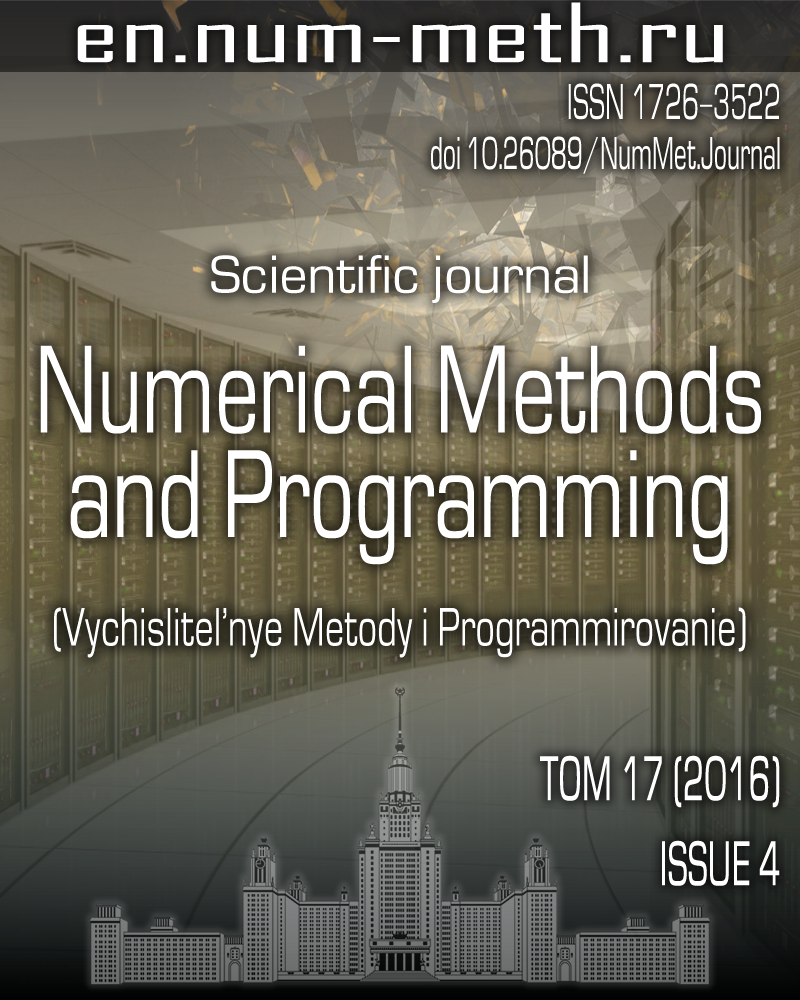Peculiarities of the boundary integral equation method in the problem of electromagnetic wave scattering on ideally conducting bodies of small thickness
DOI:
https://doi.org/10.26089/NumMet.v17r443Keywords:
boundary integral equations, hypersingular integrals, discrete singularity method, electromagnetic waves scattering, scattering cross sectionAbstract
The method of boundary integral equations with hypersingular integrals is used for the numerical solution of the classical problem of electromagnetic wave scattering on ideally conducting bodies. The corresponding integral equations are solved by the methods of piecewise constant approximations and collocation. As a result, the problem is reduced to a system of linear algebraic equations whose coefficients are expressed in terms of integrals over partition cells with a strong power singularity. These integrals are evaluated using the previously developed approach based on the extraction of terms with a strong singularity calculated analytically. The proposed numerical scheme based on the calculation of the remaining terms with weakly singular integrals over partition cells is performed by constructing a fine grid of second level with multiplication of the integrands on a smoothing factor is tested. By the example of scattering on a rectangular it is shown, in particular, that this scheme allows one to solve the scattering problem on bodies of small thickness. In this case, the thickness of a body may be less then the diameter of the first level cells. However, the diameter of the second level cells must be much less than the thickness of the body.
References
- A. S. Il’insky and Yu. G. Smirnov, Electromagnetic Wave Diffraction by Conducting Screens (Radiotekhnika, Moscow, 1996; VSP, Utrecht, 1998).
- S. M. Rao, D. Wilton, and A. W. Glisson, “Electromagnetic Scattering by Surfaces of Arbitrary Shape,” IEEE Trans. Antennas Propag. 30 (3), 409-418 (1982).
- Yu. G. Smirnov, Mathematical Methods for Electrodynamic Problems (Penza State Univ., Penza, 2009) [in Russian].
- A. G. Davydov, E. V. Zakharov, and Yu. V. Pimenov, “Method for the Numerical Solution of Problems in the Diffraction of Electromagnetic Waves by Open Surfaces of Arbitrary Shape,” Dokl. Akad. Nauk SSSR 276 (1), 96-100 (1984) [Sov. Phys. Dokl. 29, 380-384 (1984)].
- E. V. Zakharov, G. V. Ryzhakov, and A. V. Setukha, “Numerical Solution of 3D Problems of Electromagnetic Wave Diffraction on a System of Ideally Conducting Surfaces by the Method of Hypersingular Integral Equations,” Differ. Uravn. 50 (9), 1253-1263 (2014) [Differ. Equ. 50 (9), 1240-1251 (2014)].
- E. V. Zakharov, A. V. Setukha, and E. N. Bezobrazova, “Method of Hypersingular Integral Equations in a Three-Dimensional Problem of Diffraction of Electromagnetic Waves on a Piecewise Homogeneous Dielectric Body,” Differ. Uravn. 51 (9), 1206-1219 (2015) [Differ. Equ. 51 (9), 1197-1210 (2015)].
- H. Hönl, A. W. Maue, and K. Westpfahl, Theorie der Beugung (Berlin, Springer, 1961; Mir, Moscow, 1964).
- D. Colton and R. Kress, Integral Equation Methods in Scattering Theory (New York, Willey, 1983; Mir, Moscow, 1987).
- S. G. Daeva and A. V. Setukha, “On the Numerical Solution of the Neumann Boundary Value Problem for the Helmholtz Equation Using the Method of Hypersingular Integral Equations,” Vychisl. Metody Programm. 16, 421-435 (2015).
- S. G. Daeva and A. V. Setukha, “Numerical Simulation of Scattering of Acoustic Waves by Inelastic Bodies Using Hypersingular Boundary Integral Equation,” AIP Conf. Proc. 1648 (2015).
doi 10.1063/1.4912614 - E. Tyrtyshnikov, “Mosaic-Skeleton Approximations,” Calcolo 33 (1-2), 47-57 (1996).
- S. L. Stavtsev, “Block LU Preconditioner for the Electric Field Integral Equation,” in Proc. of Progress in Electromagnetics Research Symposium, Prague, Czech Republic, July 6-9, 2015 (Czech Tech. Univ., Prague, 2015), pp. 1523-1527.

